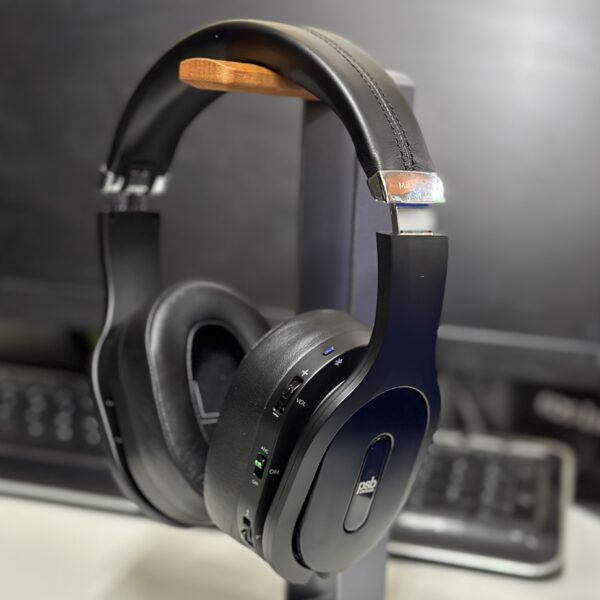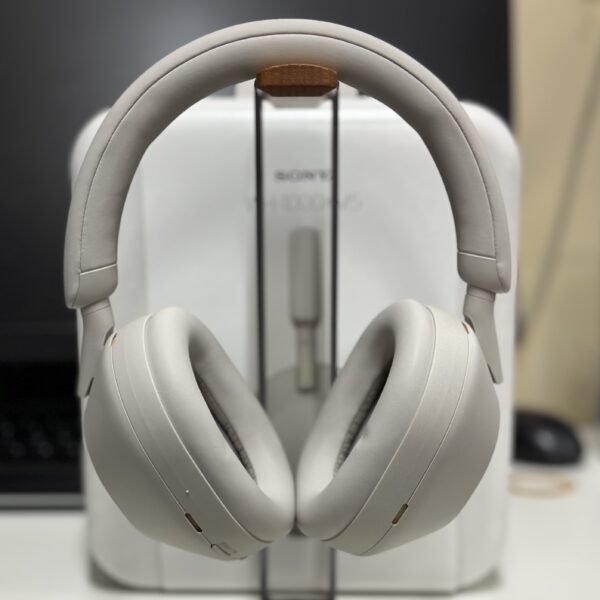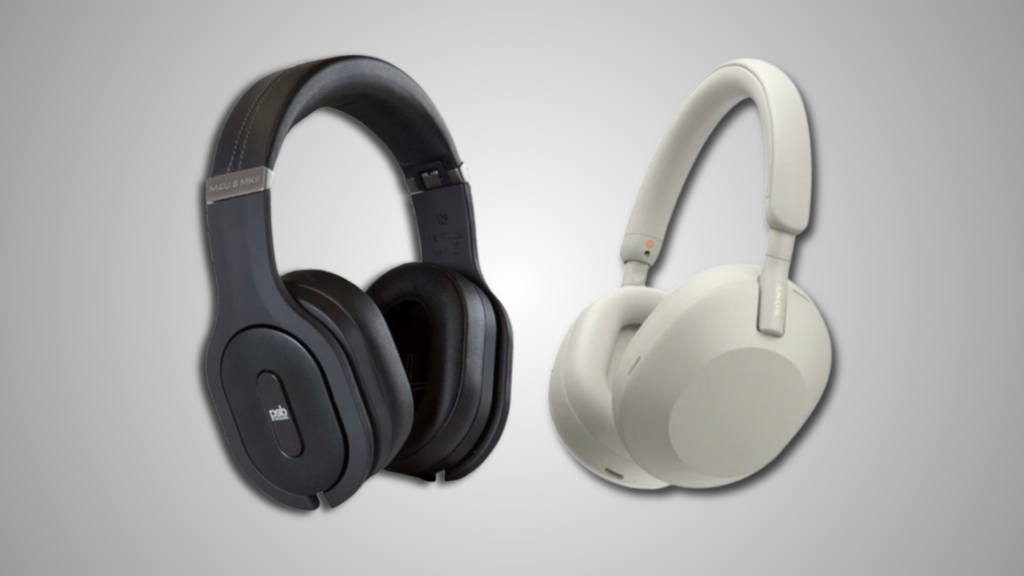Noise-canceling headphones: how do you choose? With so many options, from brands you know to ones that are trying their hand for the first time, it’s hard to tell which ones are the best for your personal needs. I’ve taken two sets of headphones, one from Sony — the WH-1000XM5 — and the other from PSB — the M4U 8 MKII — to see how the two sets of noise-canceling headphones compare. Sony has made numerous headphones in the past, while PSB has mainly specialized in speakers until recently. Who has the better headphone? Let’s compare and find out.


What Comes In The Box
| PSB M4U 8 MKII – $249 | Sony WH-1000XM5 – $398 |
| M4U 8 MKII Headphones
3.5mm Analog Cable USB-C Cable ¼” Adapter Airplane Adapter Travel Case Quick-Startup Guide Booklet |
WH-1000MX5
Carrying Case Manuals ⅛” for wired listening USB-C charging cable |
Aesthetics and Functionality
Let’s start with the look and design of these headphones. The differences between these two in terms of aesthetics would be down to the finish and the storage. The M4U is a bit on the bulkier side, sporting a gloss finish that highlights the name of the brand. The bigger ear cups collapse inwards to fold into the hardshell carrying case, where all the wires and adapters can be stored. The XM5, on the other hand, comes in with an all matte finish, making it look softer and easier on the eyes. Whether it’s in black or silver, the XM5 takes a more fashionable approach and caters towards people who would wear it as an outfit accessory. These don’t fold inward at the edges of the headband, but instead the ear cups rotate to lay flat and go into a fabric carrying case (also where you can store the wires that come with it).
Functionality wise, the two headphones operate differently since they have different controls. For the M4U, there are buttons and switches easily accessible on the back of the right ear cup. The momentary switches don’t stick out too much to be noticeable from a side profile. It collapses inward to fold easily in the carrying case, and the earcups adjust on an axis for comfortability. For the XM5, the buttons are all hidden on the bottom side of the left ear cup. The right side is touch controlled through taps and swipes to indicate what action you’d like to do: double tap to play/pause, swipe up/down for volume control, and swipe front to back for next/skip track. It keeps the clean finish throughout the control, and doesn’t require a lot of touch-pressure to perform the action.
Tech Specs
| PSB M4U 8 MKII | Sony WH-1000XM5 |
| Wireless Active Mode: 25 Hours Battery Life
Wireless ANC Mode: 18 Hours Battery Life Frequency Responses:
Impedance: Passive 32Ω Closed 40mm Dynamic Transducer Dual 3.5mm analog inputs High Capacity Batteries Total Harmonic Distortion:
|
Wireless Active Mode: 40 hours Battery Life
Wireless ANC Mode: 30 hours Battery Life Frequency Response:
Impedance:
Closed 11.82in Dynamic Driver Single 3.5mm analog input Bluetooth Version 5.2 Sensitivity:
|

Special Features
Wireless headphones naturally have a lot of highlighted special features because of the advanced technology required to integrate the Bluetooth connection. For these headphones, there is no exception. The PSB headphones certainly have a wider range of sound that you can hear has its advantages, and offers a Personal Sound feature that you can activate within the app. This feature was definitely a highlight of the headphones, as it provided some much needed tuning that made my listening experience that much better.
The Sony XM5s had a similar feature, but one they advertised and highlighted more was the Speak To Chat. With this feature turned on, the XM5s would recognize when you started a conversation with someone and automatically pause your music. When it heard you were done, it would resume the track and you wouldn’t have to touch your device at all. I found this a little creepy, if I’m honest, and also slightly flawed. If this was turned on during my morning commute, or while I walked down a busy street, I could imagine that I would never get to listen to my tracks because the headphones would think someone is talking to me all the time. Nevertheless, the feature does not stay on automatically, so users can decide if they want to test the limits with that aspect.

Listening Review
Soundstage and ANC
The soundstage for these two headphones are quite different, despite them both being closed back. The XM5s have a noticeably narrower field, which is compressed and makes the sound closed in its own bubble. The M4Us, on the other hand, have a much wider stage that sounds more natural. This is due to the RoomFeel technology that has been integrated into the PSB headphones, which the XM5 does not have. PSB is a speaker company first, so they wanted to develop headphones that had that same warm, open tone that you would get from a room. The openness allows for less fatigue when wearing, and the detail of instruments is more natural than synthetic like in the XM5. Despite the differences, both headphones have very detailed and clear sound reproduction, and image accuracy is impressive.
Each of these advertise their active noise-canceling technology, but only one truly delivers on that promise: Sony XM5. The noise-cancellation is great even when just wearing the headphones, covering the entire ear comfortably and completely. It is immediately noticeable when it turns on and off, and the sound is not compromised in any way during listening. With the PSB M4U, unfortunately, I cannot say the same thing. The noise cancellation paled in comparison, and it only became really effective when I turned the volume up. It seems as though the M4Us were focused on the audio passing through with the microphones rather than the actual noise cancellation, being that the pass-through audio is so high level with amazing clarity.
Low Frequencies
Sony XM5s take the cake when it comes to the low end. This range has a commanding presence in this pair of headphones, one that really makes songs substantial and heavy. The PSB M4U, on the other hand, doesn’t deliver as well. When the ANC is turned on, there is a good bass sound that is enjoyable. Punchy, thick, and giving a steady beat to every track I played. With the noise canceling turned off, the bass gets washed out and blends with the ambient noise that is being picked up in the room. I was losing some of the drive that accompanies the bass. The XM5s produce a great sounding low end no matter if the noise cancellation is turned on or off. Each track had a low end that served as the foundation for the rest of the sound signature to follow through with.
Mid-Range Frequencies
The mid-ranges for these headphones both have excellent detail and clarity in terms of sound reproduction. There is a great level of detail to be heard on both sets of headphones, all while keeping the quality high. There is a boxy sound that comes with the XM5s, but that may be due to the closed-back design and superior noise-cancellation technology. It’s a quality that comes with a lot of closed-back headphones, and even with some noise-cancelling ones. The frequencies cannot pass through the headphone, so they end up making reflections inside the ear cups that warp the sound you hear as you listen. I had listened to “December” by Ricky Montgomery on both sets of headphones, and it was great to hear the detail of instrumental layers come out through each set. It was noticeable in the XM5s that some of that upper mid-range became a bit boxy and hollow, but it wasn’t anything too disturbing or widespread across the range that stopped me from enjoying further listening.
High Frequencies
Both sets of headphones produced a bright and colorful high end that rounded out the frequency range. The M4U showed the same problem in the high end, however, as it did with the lows: dropping off without noise cancellation. Without the ANC on, the high end on the M4U started to drop off and disappear like the low end does with the ambient noise being passed through. It was like the frequency range became a bell curve of what I could actually hear, with the mid-range being the most prominent and then the extreme ends fading away. The XM5s, luckily, did not have this issue and instead delivered consistent high frequencies with or without noise cancellation. In comparison with the very present low end, the highs could have been boosted up a bit more, but I didn’t find it too overpowering that made it feel like I was missing something.
Summary
To conclude, there is a lot to love about both of these pairs. The main differences can be surmised to price point and noise cancellation. Both headphones deliver quality sound with high precision detail and imaging accuracy. If you are looking for a sub-$300 price point, the PSB M4Us are the way to go. They have great natural sound and the ability to really personalize your hearing profile. If you don’t mind spending a little more for better noise-cancellation, style, and comfort, then I would strongly recommend the Sony XM5s. Fans of booming bass frequencies will definitely want to choose these. No matter which you decide, you are sure to enjoy your favorite tracks with comfort and ease.
You can get both the PSB M4U MKII and Sony XM5 at Audio 46.

